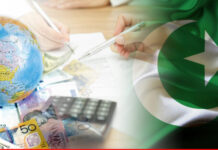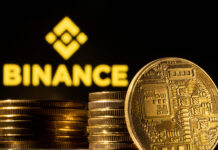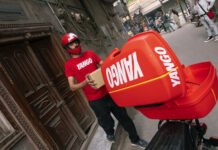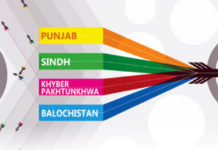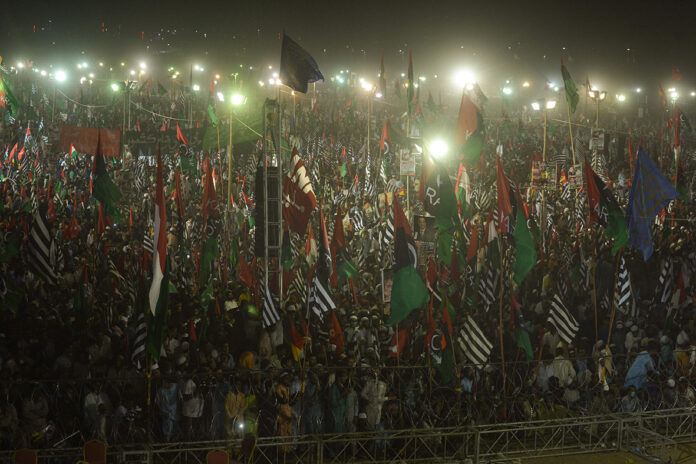When the Pakistan Muslim League-Nawaz (PML-N) announced that they would head the first public demonstration of the Pakistan Democratic Movement (PDM), there was a flurry of activity. For the other coalition members of the PDM such as the Pakistan People’s Party (PPP) and the JUI-F, it was a rare opportunity to address a mammoth crowd in the heart of Punjab – Gujranwala.
For the PML-N, it was a great weight. A show of strength can be a powerful statement, but it can also be a source of embarrassment. A lot was on the line, this first rally could either make or break the PDM, which is why there was little room for error.
The government and the media would both be breathing down the neck of the opposition, looking to find any unruly instance, and any empty seat to point out and declare that the rally had failed. So when the 16th October rally was announced in the first week of October, the mood in the Gujranwala cadre of the League was grim.
In less than two weeks, they had to mobilise workers, arrange a venue and the accompanying trappings for a rally, and also coordinate with the organisers of other parties that are a part of the PDM. A lot goes into planning a political rally. There is coaxing and cajoling, the soothing of egos still stung from past slights, arranging food and transport, marketing the event, making sure security is up to the mark, crowd control, and any number of small disasters and chaos that comes up along the way.
The one thing that follows the organisation of such an event is money. It demands weeks of tireless work and bottomless pockets to arrange a single event. What kind of economic wormhole does a large rally like the one on October 16 cause to a mid-sized city like Gujranwala? Profit looks at the economic impact of political rallies.
The stars behind the scenes
Sheikh Nauman, an alias of a PML-N loyalist wishing to remain anonymous, has been arranging political rallies for the PML-N since 2008. Back then, political zeal was high and identifying the opposition was simple. In 2008, the PML-N were part of a short-lived coalition government with the PPP before they joined the opposition.
Today, Nauman finds himself coordinating with the PPP he once arranged political events against. The enemy now is not another political party, but the bureaucratic-military establishment machine. This is a much more dangerous beast to be wrangling with, and organizing has only become more difficult in the past 12 years.
“We are a political machine. We have the support. But even then, organising an event like this demands weeks of ceaseless work and the spending of money,” says the former Gujranwala councilor. “My small flour shop remained closed for three days because I dedicated my employees to mobilise workers and hoist banners at the rally venue. I am thankful to the party leadership which tasked me with decorating the stadium and the route of the party leader, Maryam Nawaz, in the city.”
Nauman is still zealous about his party leadership. He believes that the goals of the PDM are noble, but there is a reason he is speaking to us on the condition of anonymity. The costs that come with these events have taken their toll, and Nauman, like others, feels it has become far too much.
“Political gatherings from street corners to mega-rallies have always been costly, glamorous affairs in Pakistan. But this glamour is only for the speakers standing atop the lofty stage we arrange for them,” says Nauman. “For us, they are back-breaking and a blackhole for our money. Much of the organisation comes out of our own pockets.”
But this has just been the story of one political organizer that has had to spend not just time, but significant amounts of money to arrange a rally like this. The money has stimulated different businesses from catering services to decorators and private security. But how much money are parties spending on these excursions?
Where’s the money?
There is no good way to measure exactly how much is spent on single events such as the Gujranwala rally. One of the possible ways is to try and look at it from an election-time lense. After all, that is the only time that there is any regulation or eye on how much money is being spent.
The Election Act 2017 provides a guideline of financial conduct for candidates in an attempt to keep election spending within specified limits, but such limits are not extended to cover political parties and supporters of candidates who may pay electioneering bills without seeking candidates’ permission. Besides the specified spending limits are considered unrealistically low thereby nudging people to disregard them.
The Act binds the candidates to limit spending from Rs1 million to Rs2m for a Provincial Assembly constituency election and from Rs1.5 million to Rs4 million for candidates of the National Assembly.
Sheikh Numan laughs at the numbers prescribed by the law. “I had to spend Rs5 million for a councilor election in 2016. You can imagine the cost of the election for a National Assembly election.” When asked to estimate how much was spent on the recent Gujranwala rally, he cannot quite say. “Look, the venue and decorating the city cost us Rs50 million. When you calculate the processions coming from the rest of Punjab, we can see Rs500 million being spent altogether.”
Beyond local government and donors, identifying the money trail is not just difficult but nearly impossible owing to the cash factor. There is no clear bifurcation in resources raised by candidates and parties. The important thing is that lots of people chip in the money and the real beneficiaries are wagon and bus operators, flex and banner makers, workers and caterers.
What is also important is that the local economy gets moving because of these rallies. “Politics is both good news and bad news for the economy,” says veteran political reporter Mubasher Bukhari. “I’ve been covering politics since the 90s, and have seen money dished out at the grassroots.”
Now, with the PDM on a packed schedule of demonstrations, the different venues of these rallies will all be bracing for the economic impact. Under the schedule, PDM’s rallies of Gujranwala and Karachi took place on October 16 and on October 18. The third rally will be held in Quetta on October 25, and the fourth rally on November 22 in Peshawar. The last rally of the month will be held in Multan on November 30.
In December, the PDM’s first rally will be held in Lahore on December 13, and this year’s final public gathering will be held in Larkana on December 27, on the death anniversary of Benazir Bhutto.
Naturally, the rallies in Punjab will be spearheaded by the PML-N, the ones in Sindh by the PPP, and the ones in KP by the Awami National Party (ANP) and the JUI-F. But despite the warrying regions and different local political dynamics, the way these rallies are arranged will by and large remain the same.
Along with these PDM rallies, other political events will also take place. The PML-N has planned party conferences all over the country, and elections in Gilgit-Baltistan will also draw leaders and crowds.
As the political environment continues to get charged, money and public contacts will be on full display. In the coming days, more and more chartered planes, bulletproof four-wheelers, common buses, mini buses and vans, banners, party flags and floats besides musical DJs, lights, and super amplifier systems will add to the spending.
Dynamics of political spending
“Elections and political shows are expensive, lofty, and gaudy. Huge sums of money are invested in it,” says economist Dr Qais Alam. “However, no one is ready to divulge the real details of the spending.” There is not much disagreement about this less than transparent spending.
“A political rally being held by a ruling party will have invested public resources into it, while an opposition-led rally will have investment from private pockets,” says Mubasher Bukhari. While the PML-N holds no provincial government, the PPP does have control of Sindh, which is why it is important at least for them to be transparent about where the funding for these rallies is coming from.
Back in the 2018 elections, vague and conservative estimates guessed the amount of money spent on campaigning and rallies to be somewhere around Rs440 billion. The projection was made on the basis of consolidated estimates of funding from the Election Commission of Pakistan (ECP), federal and provincial governments, security establishment, donors, political parties, candidates and their supporters.
A political campaign, spearheaded by 11 mainstream parties, is likely to generate spending in billions too. In the campaign, the lion share of a public gathering is borne by the host party.
The Gujranwala public show was all a PML-N show, whereas the October 18 rally in Karachi was completely arranged by the ruling PPP. Similarly, the Quetta rally’s bill will be paid by the Mahmood Khan Achakzai Pakhtunkhwa MilliAwami Party. The Peshawar rally will be hosted by the Awami National Party.
A public rally by a ruling party
As mentioned earlier, it makes a difference whether the party holding a rally is in power or out of it. This is not necessarily because corners are being cut or public money being embezzled, but because if a party is in power, they can use government structures in place to help move their plans for a demonstration along more smoothly, and possibly even at a lower cost.
When the PML-N was in power from 2013 to 2018, it held rallies across Punjab, often to counter Pakistan Tehreek-i-Insaf’s (PTI’s) popular public mobilisation campaign. It used public resources lavishly, says PTI leader from Okara Ashraf Sohna.
“When Prime Minister Nawaz Sharif addressed gatherings in Punjab, everything was done by the local municipality. It arranged and decorated the public venue, the stage was prepared by Sarkari people. Public vehicles were used to ferry people. Public officials were made bound to attend the gathering.”
Those living in Karachi have seen the frequent usage of municipality resources for public rallies by the Muttahida Qaumi Movement, says journalist Rehan Naqvi.
“We’ve seen the trucks owned by local government bodies carrying people to the rally venue, which is often Jinnah Avenue. Karachi University buses are also misused in the rallies. Public vehicles are used at will.”
The economy of public gathering
A public rally where the crowd is in the thousands cost millions to the organizers. PPP Muzaffargarh leader Malik Azam says he has arranged the mammoth jalsas for Benazir Bhutto in the 1990s, and the last one he organized was on December 25, 2007, two days before her assassination in Liaquat Bagh, Rawalpindi.
The last gathering was arranged with the contribution of PPP candidates for national and provincial assembly seats.
“I can’t disclose the exact amount but it was in hundreds of thousands. Every candidate was tasked with bringing 10 buses of people besides other vehicles. A lot of money was spent on flexes, banners, stage, decoration, lights, amplifier, and security.”
He says the cost of arranging a jalsa in 2020 is naturally a lot more than it was back in 2007. He said the election rally of Bilawal Bhutto-Zardari in Khangarh in 2018 cost the candidates a lot of money.
“We’ve seen a lot of rallies done with rented crowds. That increases the rally expense,” he says, smiling and winking. “But thankfully this is an expense that the PPP does not have to think about. Benazir was a crowd puller, and now Bilawal is as well.”
In the case of renting a crowd, money comes from those segments who have amassed wealth and they think it is a sort of investment on their career or business through rent, a crowd and big rallies. A good chunk of black wealth surfaces and circulates in the times of political agitation and electioneering, says a market analyst.
Those providing services for a public rally never question the payer about the means or the mode of payment. Political workers say they pay cash to the service providers instead of through money transfers through banks.



